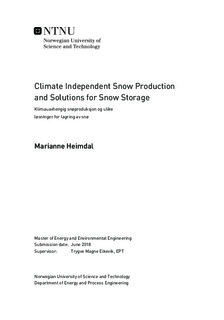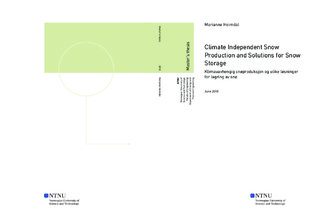| dc.description.abstract | This thesis studies different alternatives for snow storage in Granåsen (Trondheim). It is planned to improve the arena in Granåsen, which will give possibilities for future winter games and cross-country skiing facilities from October to the end of March. For that reason, it is assumed that 24 000 m3 snow is to be stored from the beginning of April to the end of September. Both outdoor and indoor snow storage are analyzed.
The snow pile stored outside will be covered with sawdust. This is already practiced in Granåsen, but with a smaller volume of snow. A multipurpose hall will be studied as an alternative for an indoor storage. No such hall exists in Granåsen today, but might be a good alternative that fits the ambition for Granåsen to become a future all-inclusive sports arena. The multipurpose hall will be used for snow storage during the summer, and can be used for indoor training and sports arrangements during the winter.
A snowmelt model has been developed in Excel. The model calculates the amount of melted snow for every hour during the storage season, with respect to weather statistics for Granåsen. The calculations show that approximately 20 % of the initial snow volume will be lost for the outdoor storage. Among the evaluated solutions to reduce the snowmelt, increasing the thickness of the insulation layer gives the best result. A solar shading wall or different snow pile geometries do not lead to any significant melt reduction. When the sawdust thickness is changes from 0.4 m to 0.8 m, the snowmelt is reduced from 20 % to 12 %. However, analysis of the costs proves this to be an expensive alternative. Maintenance of sawdust is therefore concluded to be the most important measure to reduce the snowmelt. This includes necessary drying to maintain the quality and the low thermal conductivity of the sawdust. An insulation thickness of 0.3-0.5 m sawdust can be recommended.
As it can be expected, the melting loss for the snow stored inside will be very small. If the refrigeration capacity of the hall cooling system is set to 20 kW, only 0.21 % of the initial volume will be lost. The snowmelt model demonstrates that there will be great variations in indoor air temperature at different refrigeration capacities. This is a storage alternative with high investment costs compared to the costs for the outdoor storage.
More than 50 % of the annual costs for snow storage will be related to the transportation and distribution of the snow from the storage and to the trails. It will therefore be important to have detailed strategies in advance, regarding the need for snow and how much snow which should be distributed during the winter. | |

